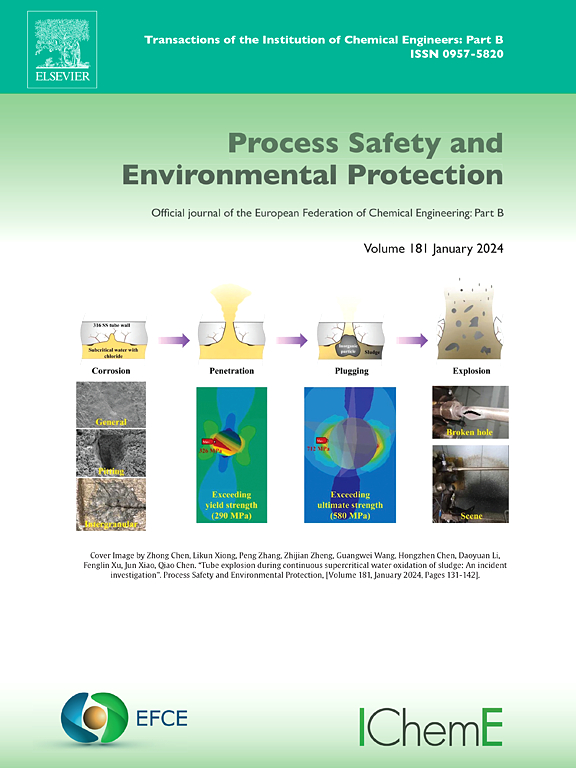隧道施工阶段湿串栅除尘车集尘入口几何优化及射流辅助效率提高
IF 6.9
2区 环境科学与生态学
Q1 ENGINEERING, CHEMICAL
引用次数: 0
摘要
钻爆法施工中的粉尘危害严重影响作业环境和人员的职业安全。湿串格栅除尘车作为一种新型的隧道降尘装置,其集尘入口的降尘性能并不理想,有很大的改进潜力。通过理论分析、数值模拟和实验验证,得到如下结果:将进气道结构优化为抛物线型,优选的几何参数为无量纲直径比1.6和无量纲长度比0.4,优化后进气道压差减小了91.04 %,控制长度和扰动体积分别增大了25.03 %和16.70 %;提出了一种射流辅助集尘入口,确定临界动量比为0.219;射流速度达到20 m/s时,控制长度增加2.59倍;对爆破后粉尘控制效果的对比分析表明,射流辅助进气道有效地阻止了粉尘向人员密集区域扩散,在车辆后方10 m处的除尘效率为95.74 %。研究结果为优化湿串网除尘车及其他除尘设备的集尘入口,改善施工隧道的环境条件提供了理论支持。本文章由计算机程序翻译,如有差异,请以英文原文为准。
Geometric optimization and jet-assisted efficiency enhancement of the dust collection inlet for tunnel construction-phase wet string grid dust removal vehicle
The dust hazard during drilling and blasting method construction significantly impacts the working environment and occupational safety of personnel. The wet string grid dust removal vehicle, as a novel tunnel dust control device, exhibits suboptimal dust control performance at its collection inlet, with great potential for improvement. Through theoretical analysis, numerical simulation, and experimental validation, the following results were obtained in this study: optimized the inlet structure to a parabolic type, with preferred geometric parameters of dimensionless diameter ratio 1.6 and dimensionless length ratio 0.4, after optimization, the pressure difference across the inlet decreased by 91.04 %, while the controlled length and disturbed volume increased by 25.03 % and 16.70 %, respectively; a jet-assisted dust collection inlet was proposed, with the critical momentum ratio determined as 0.219; when the jet velocity reached 20 m/s, the controlled length increased 2.59-fold; comparative analysis of post-blasting dust control effects revealed that the jet-assisted inlet effectively prevented dust diffusion to personnel-intensive zones, achieving a dust removal efficiency of 95.74 % at 10 m behind the vehicle. These findings provide theoretical support for optimizing dust collection inlet of the wet string grid dust removal vehicle and other dust removal equipment, as well as improving environmental conditions in construction tunnels.
求助全文
通过发布文献求助,成功后即可免费获取论文全文。
去求助
来源期刊

Process Safety and Environmental Protection
环境科学-工程:化工
CiteScore
11.40
自引率
15.40%
发文量
929
审稿时长
8.0 months
期刊介绍:
The Process Safety and Environmental Protection (PSEP) journal is a leading international publication that focuses on the publication of high-quality, original research papers in the field of engineering, specifically those related to the safety of industrial processes and environmental protection. The journal encourages submissions that present new developments in safety and environmental aspects, particularly those that show how research findings can be applied in process engineering design and practice.
PSEP is particularly interested in research that brings fresh perspectives to established engineering principles, identifies unsolved problems, or suggests directions for future research. The journal also values contributions that push the boundaries of traditional engineering and welcomes multidisciplinary papers.
PSEP's articles are abstracted and indexed by a range of databases and services, which helps to ensure that the journal's research is accessible and recognized in the academic and professional communities. These databases include ANTE, Chemical Abstracts, Chemical Hazards in Industry, Current Contents, Elsevier Engineering Information database, Pascal Francis, Web of Science, Scopus, Engineering Information Database EnCompass LIT (Elsevier), and INSPEC. This wide coverage facilitates the dissemination of the journal's content to a global audience interested in process safety and environmental engineering.
 求助内容:
求助内容: 应助结果提醒方式:
应助结果提醒方式:


